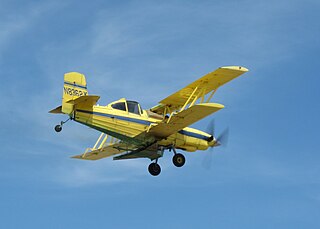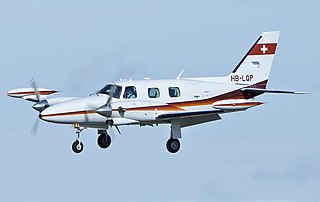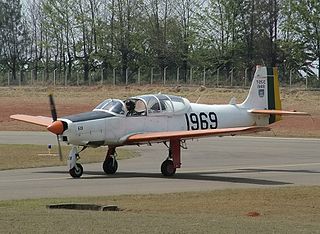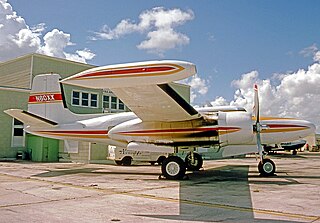
The de Havilland Canada DHC-3 Otter is a single-engined, high-wing, propeller-driven, short take-off and landing (STOL) aircraft developed by de Havilland Canada. It was conceived to be capable of performing the same roles as the earlier and highly successful Beaver, including as a bush plane, but is overall a larger aircraft.

The Piper PA-44 Seminole is an American twin-engined light aircraft manufactured by Piper Aircraft.

The Grumman G-164 Ag Cat is a single-engined biplane agricultural aircraft, developed by Grumman in the 1950s.

The Canadair CL-66 was a turboprop version of the civilian Convair CV-440 Metropolitan. The CC-109 Cosmopolitan or "Cosmo" in RCAF service became the standard VIP aircraft as well as replacing the Douglas Dakota and the North American B-25 Mitchell in light transport duties. After a lengthy career stretching into the 1990s, the CC-109 was replaced by the CC-142 Dash 8 and CC-144 Challenger.

The Cessna 425, known as the Corsair and later as the Conquest I, is an eight-seat American pressurized turboprop twin-engined light aircraft. Now out of production, it was built by Cessna Aircraft of Wichita, Kansas, between 1980 and 1986.

The Noorduyn Norseman, also known as the C-64 Norseman, is a Canadian single-engine bush plane designed to operate from unimproved surfaces. Distinctive stubby landing gear protrusions from the lower fuselage make it easily recognizable.

The Piper PA-31T Cheyenne is a turboprop development of the earlier PA-31P Pressurized Navajo.

The Cessna 421 Golden Eagle is an American six or seven seat twin-engined light transport aircraft, developed in the 1960s by Cessna as a pressurized version of the earlier Cessna 411.

The MKEK-4 Uğur was a basic trainer aircraft which was used by the Turkish Air Force between 1955-1963. Originally developed as the THK-15, in total 57 Uğurs were produced in Turkey, all of which were used in the Turkish AF Flight School except three which were donated to the Royal Jordanian Air Force.

The Fokker S.13 Universal Trainer was a dual engine propeller aircraft for training purposes designed and manufactured by the former Dutch aircraft manufacturer Fokker.

The Thruxton Jackaroo was a 1950s British four-seat cabin biplane converted from a de Havilland Tiger Moth by Jackaroo Aircraft Limited at Thruxton Aerodrome and Rollason Aircraft and Engines Limited at Croydon Airport.

The Agusta AZ.8L, or Agusta-Zappata AZ.8L, was an Italian airliner prototype first flown on 9 June 1958. It was of conventional low-wing monoplane configuration with tricycle undercarriage and all-metal construction. Filippo Zappata's design grew out of a twin-engined transport designated AZ.1 that was never built.

The Neiva N621 Universal is a Brazilian propeller-driven basic trainer and ground attack aircraft manufactured by Indústria Aeronáutica Neiva. It is a cantilever, low-wing monoplane of all-metal construction, with retractable undercarriage and side-by-side seating.
The Boisavia B.260 Anjou was a four-seat twin-engine light aircraft developed in France in the 1950s. It was a low-wing cantilever monoplane of conventional configuration with retractable tricycle undercarriage. Intended by Boisavia as a touring aircraft, it did not find a market and only the single prototype was constructed. At this point, the firm sold the design to SIPA, which modified the design and re-engined it with Lycoming O-360 engines, but found that they could not sell it either. At a time when the twin-engine light plane market was already dominated by all-metal American aircraft, the Anjou's fabric-over-tube construction was something of an anachronism, and all development was soon ceased. Plans to develop a stretched version with three extra seats and Potez 4D engines were also abandoned.

The Call-Air Model A is an American two- to three-seat utility aircraft designed by the Call brothers and built by the Call Aircraft Company, later developed into a successful line of agricultural aircraft.

The Colonial Model C-1 Skimmer was an American small single-engined amphibian flying boat built by the Colonial Aircraft Corporation. It was the start of a line of very similar aircraft designed by David Thurston.

The On Mark Marksman was an American high-speed civil executive aircraft converted from surplus Douglas A-26 Invader airframes by On Mark Engineering. Its antecedents were the On Mark Executive and the On Mark Marketeer.
The Janowski J1 Prząśniczka ("Distaff"), later named the Don Kichot was an ultralight aircraft designed in Poland and marketed for homebuilding in the 1970s. Designed by Jarosław Janowski in 1967 and built with the help of some friends, it flew three years later. It had an unusual design, with a high, strut-braced wing and a pusher propeller mounted behind it. The pilot had a fully enclosed cabin, and the undercarriage was of fixed, tailwheel type. Original prototype was flown with Saturn engine design by Mr Janowski. This engine was made out of two motorcycle engines (MZ250). J1 was also flown with Trabant engine (29HP) and VW conversion (48BPH) made by Christine Aero Engines in Donlands - California.

The Larson D-1 was an agricultural biplane that was purpose-built to replace Boeing Stearman cropdusters.
The IAR-811 was a Romanian trainer aircraft built in the late 1940s. It was the first aircraft designed and built in Romania following the end of the Second World War.

















